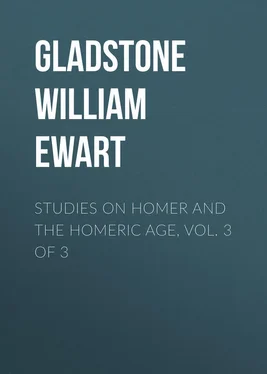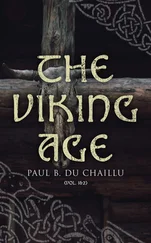William Gladstone - Studies on Homer and the Homeric Age, Vol. 3 of 3
Здесь есть возможность читать онлайн «William Gladstone - Studies on Homer and the Homeric Age, Vol. 3 of 3» — ознакомительный отрывок электронной книги совершенно бесплатно, а после прочтения отрывка купить полную версию. В некоторых случаях можно слушать аудио, скачать через торрент в формате fb2 и присутствует краткое содержание. Жанр: foreign_antique, foreign_prose, на английском языке. Описание произведения, (предисловие) а так же отзывы посетителей доступны на портале библиотеки ЛибКат.
- Название:Studies on Homer and the Homeric Age, Vol. 3 of 3
- Автор:
- Жанр:
- Год:неизвестен
- ISBN:нет данных
- Рейтинг книги:4 / 5. Голосов: 1
-
Избранное:Добавить в избранное
- Отзывы:
-
Ваша оценка:
- 80
- 1
- 2
- 3
- 4
- 5
Studies on Homer and the Homeric Age, Vol. 3 of 3: краткое содержание, описание и аннотация
Предлагаем к чтению аннотацию, описание, краткое содержание или предисловие (зависит от того, что написал сам автор книги «Studies on Homer and the Homeric Age, Vol. 3 of 3»). Если вы не нашли необходимую информацию о книге — напишите в комментариях, мы постараемся отыскать её.
Studies on Homer and the Homeric Age, Vol. 3 of 3 — читать онлайн ознакомительный отрывок
Ниже представлен текст книги, разбитый по страницам. Система сохранения места последней прочитанной страницы, позволяет с удобством читать онлайн бесплатно книгу «Studies on Homer and the Homeric Age, Vol. 3 of 3», без необходимости каждый раз заново искать на чём Вы остановились. Поставьте закладку, и сможете в любой момент перейти на страницу, на которой закончили чтение.
Интервал:
Закладка:
We may therefore take the polity, so to speak, of the Greek army into a common view with that of the Ithacan ἀγορή; but first it will be well to sketch its military organization.
Its military composition.
Next to the βασιλῆες came the ἔξοχοι ἄνδρες (Il. ii. 188), or ἀριστῆες, of the Greek army. They are pretty clearly distinguished from the kings in the speech of Achilles (ix. 334); when, after describing the niggardliness of Agamemnon with respect to booty, he goes on to say, which I understand to mean, he gave to these two classes prizes different, i. e. proportioned to their respective stations.
ἄλλα δ’ ἀριστήεσσι δίδου γέρα καὶ βασιλεῦσιν·
The language of the Catalogue pointedly marks the same distinction in other words. At the beginning, the Poet invites the Muses to tell him (ver. 487),
οἵτινες ἡγεμόνες Δαναῶν καὶ κοίρανοι ἦσαν,
and at the close he says (ver. 760),
οὗτοι ἄρ’ ἡγεμόνες Δαναῶν καὶ κοίρανοι ἦσαν.
These two verses appear to be in evident correspondence with each other: and if so, we may the more confidently rely on the language as carefully chosen to describe the two classes, first the kings as κοίρανοι (cf. Il. ii. 204, 207), and, secondly, the ἀριστῆες as ἡγεμόνες.
This class, it is probable, consisted,
First, of the leaders of the minor and less significant contingents.
Secondly, of lieutenants, or those who are named in the Catalogue as holding inferior commands under the great leaders (such as Meriones, Sthenelus, and Euryalus).
But, below the ἡγεμόνες of the Catalogue, there would appear to have been several grades of minor officers, in command of smaller subdivisions of the army. These would seem to have been described by a general name, ἡγεμόνες. When Nestor (ii. 362) advises the distribution of the army according to φῦλα and φρήτραι, it will, he says, have the advantage of showing not only which of the soldiers, but which of the officers were good, and which bad. Probably therefore there were officers of each φῦλον, if not even, under these, of each φρήτρη.
Of the Greeks nine are named in Il. xi. 301-3, who were slain by Hector at once, before he went among the privates (πληθύς). Of these nine no one is mentioned in any other part of the poem; and since at the same time they are expressly declared to be ἡγεμόνες, we may safely look upon them as examples of the class of minor or secondary officers. From their names, which have a strong Hellenic colour 181 181 Vid. Achæis or Ethnology, p. 574.
, we may venture at least to conjecture, that this class was chiefly Achæan, or of Achæan rank, and that the Pelasgian blood of the army was principally among the common soldiers.
The maritime order of the armament, which required a commander for each vessel, necessarily involved the existence of a class of what we may call subaltern officers.
When Helen describes the chieftains to Priam from the tower, of whom Idomeneus is one, she proceeds (Il. iii. 231);
ἀμφὶ δέ μιν Κρητῶν ἀγοὶ ἠγερέθονται.
Again, when Achilles went with fifty ships to Troy, he divided his 2500 men under five ἡγεμόνες, whom he appointed to give the word of command (σημαίνειν) under him. The force thus arranged formed five στίχες or ranks, Il. xvi. 168-72: and here the private persons are expressly called ἑταῖροι (ver. 170). Most probably these ἀγοὶ of the Cretans, and these five Myrmidon leaders, are to be considered as belonging to a class below the ἀριστῆες, yet above the subalterns.
Lastly, we have to notice the privates, so to speak, of the Greek army, who are called by the several names of λαὸς (Il. ii. 191. i. 54), δῆμος (ii. 198), and πληθὺς (ii. 278).
In their military character they are indeed a mass of atoms, undistinguishable from one another, but yet distinguished by their silence and order, which was founded probably on confidence in their leaders.
The descriptions of fighting men.
No private or nameless 182 182 Even the instance, in Il. xiii. 211, of a nameless person who had simply been wounded is a rare, if not indeed the single, exception.
person of the Greek army, however, on any occasion performs any feat, either great or small: these are always achieved by the men of birth and station: and the three designations we have mentioned, the only ones which are used to designate the whole mass of the soldiery, represent them to us as a community bearing arms, rather than as an army in any sense that is technical or professional.
All these were entitled to attend the ἀγορὴ, or Assembly, if they pleased. And accordingly, on the first Assembly that Achilles attended after renouncing his wrath, we find that, from the great interest of the occasion, even those persons were present who did not usually appear: namely, the pilots of the ships, and others who probably had charge of them while ashore, together with those who managed the provisioning of the force (ταμίαι), or, in our language, the commissariat (Il. xix. 42-5).
In their strictly military capacity they were, however, divided into
1. ἱππῆες, who fought in chariots, commonly (Il. xxiii. 334-40) with two horses. When there were three (xvi. 467-75), the outrunner was called παρήορος. The chariot of Hector was drawn by four horses (viii. 185), but we have no such case among the Greeks. Two persons went in each chariot; of whom the inferior (ἠνίοχος) drove, and the superior (παρέβασκε) stood by him free to fight. But probably none of these ἱππῆες were of the mere πληθὺς of the army, or common soldiery.
2. ἀσπισταί, the heavy-armed, of the σταδίη ὑσμίνη. These use the longer spear, the axe, the sword, or the stone.
3. ἀκοντίσται, using the lighter spear (Il. xv. 709. xxiii. 622. Od. xviii. 261).
4. τοξόται (Il. ii. 720. iii. 79).
Again, the men are distinguished by epithets according to merit; each being ἔξοχος, μεσήεις, or χερειότερος (Il. xii. 269), or even κακός; and with the last-named the precaution is taken to place them in the midst of their comrades.
The policy of Nestor, which recommended the muster of the whole army, with a view to stronger mutual support among those who had peculiar ties, was entirely in harmony with what we meet elsewhere in the poems. For instance, in the defence of the rampart in the Thirteenth Book, we find Bœotians, Athenians, and Locrians 183 183 Il. xiii. 685.
, who were neighbours, all mentioned as fighting side by side.
All ranks apparently went to the Assemblies as freemen, and were treated there by their superiors with respect. It was not those of the common sort in general, but only such as were clamorous for the tumultuary breaking up of the Assembly, that Ulysses went so far as to hit (ἐλάσασκε) with the staff he bore, the supreme sceptre of Agamemnon. In addressing them he used the word δαιμόνιε, the same word which he employed to their superiors, the kings and chiefs (Il. ii. 190, 200). When they heard a speech that they approved of, they habitually and immediately shouted in applause 184 184 Il. ii. 333.
,
Ἀργεῖοι δὲ μέγ’ ἴαχον …
μῦθον ἐπαινήσαντες Ὀδυσσῆος θείοιο·
and they commented freely among themselves on what occurred (Il. ii. 271 and elsewhere).
The modes of warfare in the heroic age were very simple: the open battle was a battle of main force, as regarded both the chieftains and the men, relieved from time to time by a sprinkling of panics. But besides the battle, there was another and a more distinguished mode of fighting: that of the λόχος or ambuscade. And the different estimate of the two, which reverses the popular view, is eminently illustrative of the Greek character.
Читать дальшеИнтервал:
Закладка:
Похожие книги на «Studies on Homer and the Homeric Age, Vol. 3 of 3»
Представляем Вашему вниманию похожие книги на «Studies on Homer and the Homeric Age, Vol. 3 of 3» списком для выбора. Мы отобрали схожую по названию и смыслу литературу в надежде предоставить читателям больше вариантов отыскать новые, интересные, ещё непрочитанные произведения.
Обсуждение, отзывы о книге «Studies on Homer and the Homeric Age, Vol. 3 of 3» и просто собственные мнения читателей. Оставьте ваши комментарии, напишите, что Вы думаете о произведении, его смысле или главных героях. Укажите что конкретно понравилось, а что нет, и почему Вы так считаете.












